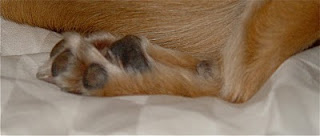
When a dog shows the tricks it knows, people always reach out their hands and demand, “Shake!”
Joey can’t stand having his feet handled. I know from our hours at J9’s K9’s dog college that he could be trained to get over that sensitivity. Alas, I think there aren’t enough hours in my lifetime or thinly sliced roast beef in my budget to desensitize him.
When he’s very relaxed and if I’m slow and gentle enough, he’ll let me touch his paws. I love the contrast between the rough, calloused pads and the silky fur between them. I like running the tip of my finger gently down the valley between the two bones above his biggest pad.
But just imagine walking on your hands and toes . . . being able to leap higher than you are tall . . . walking on ice, burning hot sidewalks and gravel without shoes . . . digging for underground prey.
In many ways, dog paws and lower limbs are analogs for human hands and feet.A dog walks on its toes, the equivalent of the four human fingers. Where we have thumbs, the dog has dewclaws, but much further away than our thumbs are from our fingers. The pads of a dog’s paw are the like pads that a palm reader examines at the base of the fingers.
Hare Feet and Cat Paws
Dog paws are described as:
- Cat paws if they are rounded and compact. Hunting, herding and hauling dogs have paws like this. Being smaller, they take less energy to lift and give a dog better endurance in the field. Dogs with these paws include English sheep dogs, Newfoundlands, Dobermans, Akitas, Airedale and bull terriers, keeshonds, Finnish spitzes and giant schnauzers
- Hare feet, if they have two long central toes with shorter toes on either side. Dogs with hare paws include terriers such as the Bedlington and Skye, several toy breed, borzois and greyhounds.
There are other differences in paws as well. Water dogs — some spaniels, pointers or retrievers, for example– have webs between their toes to help them paddle.

The Pads
A dog’s paw has a pad for each toe and two pads higher up its leg. The pads (along with their leg joints) absorb the weight of their bodies as they walk, run and jump. The fur that grows between the pads is designed to prevent blisters as the pads move against each other. the pads are one of the few parts of a dog’s body that can perspire.
The Claws
Where human nails are flat and shield-like, dog claws are round. In some dogs, the claws are soft enough that long, frequent walks will keep them in good trim. Others have nails so tough they need clipping even when the dog is well exercised.Letting a dog’s claws get too long keeps its foot from rolling forward properly as he walks. It forces the dog to rock back on its paws, straining joints and disturbing its gait.
A Window of Health
The health of a dog’s paws says much about the dog’s health in general. Cracked, swollen or bleeding paws are signs of trouble. Some of the conditions that can affect a dog’s paws include:
- Allergies or irritants that a dog has walked in. Examples include carpet cleaners, chemicals spilled on sidewalks or streets or garden and lawn treatments.
- Infections due to yeast or other fungi
- A lack of zinc in the diet. Some breeds are more prone to this than others. Rapidly growing dogs are also more prone to it.
- Nasodigital hyperkeratosis, in which the tough outer covering of the pads grows excessively. This can happen to older dogs and affects the bridge of the nose and the ears as well as the foot pads.
- Autoimmune disease such as pemphigius, in which the dog’s body attacks its own skin cells causing pus-filled sores on the pads, bridge of the nose or ears. The sores eventually break open and crust over.